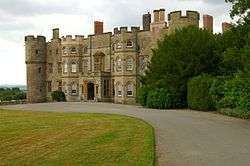Croft Castle
| Croft Castle | |
|---|---|
|
Croft Castle in 2010 | |
| Coordinates | 52°17′05″N 2°48′33″W / 52.28486°N 2.80916°WCoordinates: 52°17′05″N 2°48′33″W / 52.28486°N 2.80916°W |
| OS grid reference | SO 449 655 |
| Website |
www |
Croft Castle is a castle, church and garden located at Yarpole, Herefordshire, England.[1][2][3][4]
It is a National Trust property which is open to the public.
Location
The site is located at Yarpole,[5] 5 miles (8.0 km) north-west of Leominster,[6] in Herefordshire, England. It is surrounded by 1,500 acres of woodland, farmland and parkland.[5] It is at grid reference SO449655.
The Mortimer Trail, a long-distance footpath, passes by.
Castle

A building has been on the site from the 11th century and it has from this time been the home of the Croft family and Croft baronets. The Croft family were closely linked to their neighbours the Mortimers of Wigmore and later Ludlow. The Battle of Mortimer's Cross took place on Croft lands nearby in 1461. The present building originated as a castle in the 14th century and has been much altered since. It was the home of a John Croft who married one of Owain Glyndŵr's daughters. In the 15th century the Croft family adopted the Welsh Wyvern crest, a wounded black dragon, seen as a subtle allusion to their Glyndwr heritage. Croft Castle was restored after slighting in the Civil War. It now consists of a stone quadrangular manor house with a small castellated round tower at each corner and a small square tower flanking the north side. The castle is under the care of the National Trust and members of the Croft family still live within it.
The manor house has a quadrectangular structure around a central courtyard. The north side of the building is not parallel to the south side. The outside walls of the building date from the 15th century. The building has four circular towers on each corner of the structure, although they are too slender to be defensive structures. The north range is Elizabethan, while the other ranges date later than 1746, and are Georgian in design. The building originally had a parapet, which was later removed. The sash windows were a later addition. The entrance porch, which has flanking parapets, is also Georgian, although it may have been located on the site of a former gatehouse.[6]
The castle was the home of the Croft family for nearly 1000 years.[5] It may have been built by Richard Croft. The Croft family was recorded as living in the structure in the Domesday Book. It was purchased by Richard Knight in 1746.[6] The building was bought back by the Croft family in 1923.[5]
It was Grade I listed by Historic England on 8 November 1956.[7] It is similar in appearance to Treago Castle.[6]
Chapel

The chapel is dedicated to St Michael, and dates to the 13th century..
It contains the tomb of Richard Croft[6] and his wife Eleanor (née Cornwall). Eleanor was the daughter of Sir Edmund Cornwall, Baron of Burford in Shropshire, and the widow of Sir Hugh Mortimer of Kyre Wyard and Martley, Worcestershire, who was killed in action at the Battle of Wakefield on 30 December 1460.[8]
Garden

The property has a walled garden than includes a vineyard, orchard and a glasshouse dating from 1908. It also has a Georgian stable block.[5]
The estate has an avenue of Spanish Chestnut trees, oaks and beech trees.
Hill fort
The parkland includes an Iron Age hill fort,[5] known as Croft Ambrey.[6]
Family
Members of the Croft family include:
- Sir Richard Croft (1429/30-1509), royal official for Kings Edward IV, Edward V, Richard III, and Henry VII
- Thomas Croft (c.1435-1488), shipowner and patron of Atlantic exploration
- Sir James Croft (c.1518-1590), lord deputy of Ireland and leading conspirator in Wyatt's Rebellion
- Herbert Croft (1603-1691), bishop of Hereford, chaplain to King Charles I and dean of the chapels Royal to Charles II
- William Croft (c.1678-1727), organist and composer
- Sir Herbert Croft (1751-1816), writer and lexicographer
- Sir Richard Croft (1762-1818), physician and man-midwife
- Sir Henry Page Croft (1881-1947), 1st Baron Croft, soldier and politician, Under-Secretary of State for War 1940-1945
- Sir James Herbert Croft (1907-1941), died on active service with No 1 Commando
See also
- Knight v Knight (1840) 3 Beav 148
References
| Wikimedia Commons has media related to Croft Castle. |
- ↑ "Croft Castle". Herefordshire Council. Retrieved 2 May 2015.
- ↑ "Croft Castle". CastleUK.net. Retrieved 2 May 2015.
- ↑ "Croft Castle". Castle Wales. Retrieved 2 May 2015.
- ↑ Fry, Plantagenet Somerset (1980). The David & Charles Book of Castles. David & Charles. ISBN 0-7153-7976-3.
- 1 2 3 4 5 6 "Croft Castle and Parkland". National Trust. Retrieved 2015-05-01.
- 1 2 3 4 5 6 Pettifer, Adrian (2002). English Castles: A Guide by Counties. Boydell & Brewer. pp. 95, 102. ISBN 978-0-85115-782-5.
- ↑ "Croft Castle". Historic England. Retrieved 2015-05-01.
- ↑ "Martley: The Mortimers". Retrieved 2 May 2015.
